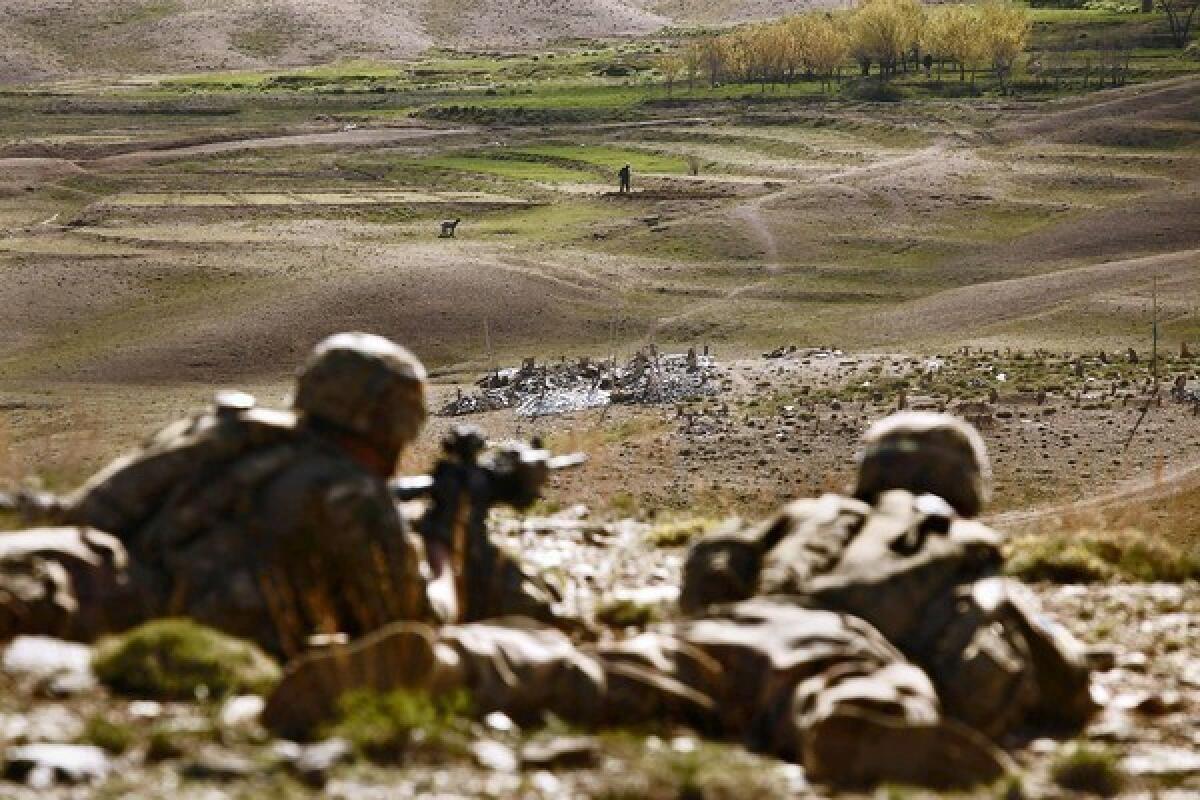For one U.S. Army unit, Afghan Highway 1 is job No. 1

- Share via
SULTAN KHEYL, Afghanistan — Highway 1 runs like a broken spine through Wardak province. Even with its potholes and cracked asphalt, it is a lifeline for soldiers and civilians alike.
The dusty highway links Wardak to Kabul, the capital, about an hour northeast. For Afghans here, it’s the main avenue for commerce, government and family connections. For the U.S. infantrymen of Bravo 3-15, it’s ultimately their way home.
In this landlocked nation, the most cost-effective way out for U.S. soldiers and equipment is Highway 1 to the capital. When American forces south and west of Kabul pack up to leave in coming months, most will exit via Highway 1. The road is also the primary route for supplies and war materiel that keep Bravo 3-15 functioning in its cramped, hilltop outpost overlooking the highway.
Like most U.S. troops in Afghanistan, the soldiers of Bravo 3-15 are helping the Afghan military prepare to take over security responsibilities. But for them, an even more urgent mission is keeping Highway 1 open and secure.
“Our focus has to be on Highway 1,” the Bravo Company commander, Capt. Collin Hamel said, jabbing at a military map in the fortified outpost. “It’s strategic. And it’s super-kinetic here,” meaning there’s a lot of shooting.
The highway, crammed with creaking trucks sagging under heavy loads, is a prime target for insurgents who control the hinterlands on either side of the road. They mine the highway with homemade bombs and regularly open fire on U.S. and Afghan military patrols
Mingled with the militants are criminal gangs and mafia-like clans who prey on truckers and civilians. They kidnap truck drivers for ransom. They seize their rigs at gunpoint and sell their cargo, Robin Hood-like, at bargain prices to eager local customers.
The gangs also team with corrupt Afghan contractors in insurance scams: They unload trucks, set them on fire, then file insurance claims. They also set up illegal checkpoints and charge “taxes” for truckers and motorists to pass. They traffic in guns, bomb components and opium.
“They’re basically bandits and thieves, but their secondary job is helping the Taliban fight us and the ANA,” Hamel said, referring to the Afghan National Army.
For Hamel, combating these threats means long days and nights of coordinating with Afghan military and police commanders in a never-ending struggle to keep Highway 1 open.
“It’s like a bunch of little wars, all overlapping in the same place,” he said.
Many U.S. units stay on their bases and mentor Afghan forces. Bravo 3-15, part of Task Force Vanguard of the 3rd Infantry Division, sends out patrols to find and remove improvised bombs. The task force’s only fatality since arriving in mid-February came from an explosion that killed Pfc. Barrett L. Austin on Highway 1 on April 21.
Bravo 3-15 also mounts patrols to secure the rocky, rugged terrain surrounding the walled outpost, which sits nearly 8,000 feet above sea level. Other U.S. forces are posted elsewhere along the 50-mile stretch of Highway 1 in Wardak.
Task Force briefing documents call Wardak “The Southern Gate of Kabul — Historically, you win the fight for Kabul in Wardak.”
In the 1980s, the Soviet army struggled to keep Highway 1 in Wardak open to Kabul in the face of persistent militant attacks. In the early 1990s, the road was crucial to all sides in the Afghan civil war. In 1995, the Taliban defeated rival militias in Wardak on its way to seizing Kabul.
“We’re the key to Kabul here,” said Lt. Col. Joel Smith, who commands the 3rd Battalion, 15th Infantry Regiment, which includes Bravo Company. “The Taliban would love to push right through Wardak and move in on Kabul.”
The task force is in a race to train the Afghan military to keep the highway secure after U.S. combat forces withdraw next year. Afghans now plan most of their own missions, but U.S. soldiers often conduct “overwatch,” protecting the Afghans’ rear and providing attack aircraft and medical evacuation in certain situations.
On one recent overwatch, a U.S. platoon of two dozen infantrymen followed a patrol of Afghan soldiers who filed out of their base next door. The Afghans were bound for a nearby village, Shamshay Kala, to search for Taliban fighters, bomb components or weapons caches.
No U.S. forces had searched the village in a year, and Capt. Hamel suspected that insurgents were using it as a base to attack the highway. He also wanted Afghan soldiers to build trust with villagers and draw them away from the Taliban. It has often been difficult for U.S. forces, as outsiders, to win the confidence of ordinary Afghans.
The U.S. soldiers hiked to a rocky plateau with a clear view of the village and Highway 1. They lay on their bellies and peered through rifle scopes as the Afghans began searching mud-walled farm compounds.
A Czech army lieutenant, a mentor to the Afghan unit, kept up steady radio chatter in Czech and English with fellow Czech soldiers who accompanied the Afghans, assisted by an Afghan interpreter. The Czech lieutenant relayed updates to the U.S. platoon leader, Lt. Michael Rissberger, who watched the village through binoculars.
Over the next two hours, the Americans stood overwatch as the Afghans methodically searched the village. There were few fighting-age men with the women and children; Rissberger believed they had fled the hamlet before the patrol’s arrival.
As the U.S. infantrymen watched through their scopes, they were grateful to be out on a mission, even in a support role, rather than stuck on their base.
“Time goes too slowly when you’re just sitting on the FOB,” or forward operating base, said Pvt. Tyler Hartzheim, 20, from the Palos Verdes Peninsula, who attended Santa Monica College before signing for a three-year Army hitch.
Sgt. Christopher Lee, 23, of Beverly Hills lay on his belly, his rifle aimed toward the village. He said he hadn’t seen enough of the Afghan army to draw conclusions about its performance, but he knew the Afghans needed to be ready to fight on their own soon.
“The war is coming to a close for us,” Lee said. “Pretty soon we’ll be out of here, and it’ll be up to them.”
The Afghan patrol came away empty-handed, except for a 107-millimeter artillery round, which was detonated by a U.S. explosive ordnance team.
On the long hike back to base, the patrol encountered Faqir Mohammed, 60, warming himself in the sun. Asked whether the village housed any Taliban fighters, the bearded elder shook his head fiercely.
“No,” he said. “There are no Taliban. Just us. We want the army. We appreciate them.”
Back at the base, the Afghan patrol commander, 1st Lt. Hamidullah, 27, who goes by one name, seemed skeptical. Like Capt. Hamel, he suspected that insurgents were using the village to stage attacks or plant bombs on the highway.
The lieutenant spoke over the low rumble of trucks plying the highway to Kabul. “We’ll be back,” he said.
More to Read
Sign up for Essential California
The most important California stories and recommendations in your inbox every morning.
You may occasionally receive promotional content from the Los Angeles Times.














